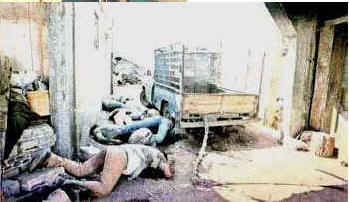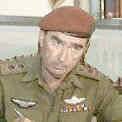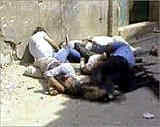|
Summary |
In 1982, the Zionist warlord (Ariel Scheiderman aka Ariel Sharon),
invaded Beirut to kill off the PLO. During the invasion, 30,000
innocent Lebanese were killed. President Reagan talked the PLO into fleeing to
Tunisia, but their families stayed in the Sabra and Shatilla refugee
camps. Sharon sent in an Israeli proxy force, known as the Phalange Militia,
and they killed 3500 women, and children of the PLO families.
In 2001, a Belgian court decided to prosecute Ariel Sharon. Before the trial could begin, the three main witnesses against
Sharon were assassinated.
|
Elie Hobieka
 |
The Mossad had a parked car, loaded with explosives, along
Hoeika's route, and when Hobeika's Land Rover drove by, they
detonated the bomb.
The explosion killed three people, and damaged surrounding
buildings.
|
 |
|
|
Mr Ghanem
 |
Mr Ghanem was Hobeika's political deputy, and he held documents
that Hobeika intended to present to Belgian lawyers in their
attempt to indict Mr Sharon for the Sabra massacres.
Ghanem died of a heart attack, while driving, a few hundred
meters from where Hoebika died four days before.
|
|
Michael Nassar
 |
Michael Nassar was Phalangist leader involved in the massacre,
and planned to testify. He was shot dead in Brazil by a man firing a pistol equipped with a silencer. His young wife, Marie, was shot down beside him.
With the deaths of these three key witnesses, the secrets of the Sabra and Shatilla
Palestinian camp massacres in 1982 have gone to the grave.
|
Ariel Schiederman aka
Ariel Sharon ---- A complete insult to humanity.
|
The Massacre of Sabra and Shatilla in 1982
|

|
|

|
|
 |
|
|
|
The Sabra and Shatilla massacre was one of the most barbarous events in
recent history. Thousands of unarmed and defenseless Palestinian refugees--
old men, women, and children-- were butchered in an orgy of savage killing.
On December 16, 1982, the United Nations General Assembly condemned the
massacre and declared it to be an act of genocide.
Background of the massacre
The Sabra and Shatilla massacre was an outcome of the alliance
between Israel and the Lebanese Phalangists. In its long-standing war
against Palestinian nationalism and against the Palestine Liberation
Organization, Israel found an ally in the Lebanese Phalangists.
Despite the fact that Israel was itself responsible for the
Palestinian exodus, the common feelings of hostility of Israel and the
Phalangists to the Palestinians led to a secret alliance between them.
In execution of this alliance, Israel supplied the Phalangists with
money, arms and equipment to fight the PLO in Lebanon.
|
 |
Terror had led to the exodus of a large number of
Palestinians in 1948. Therefore, the motivation for causing by similar
means, another exodus of Palestinians, this time from Lebanon, was a common
objective of Israeli leaders, and their Phalangist allies. The massacre was
not a spontaneous act of vengeance for the murder of Bashir Gemayel, but an
operation planned in advance, aimed at effecting a mass exodus by the
Palestinians from Beirut and other parts of Lebanon. Israel's participation
in prior massacres, directed against Palestinian people, creates a most
disturbing pattern of a political struggle carried on by means of mass
terror directed at the civilians, including women, children, and the aged.
Israel Moves Into West Beirut
|

|
The decision to move into West Beirut was taken by Israeli Prime
Minister Menachem Begin and Israeli Defense Minister Ariel Sharon,
although it constituted a violation of the cease-fire and the
agreement which governed the PLO evacuation. It was also a breach of
Israel's word to President Reagan not to enter West Beirut after the
PLO's departure. The IDF, however, did not enter the Sabra and Shatilla
refugee camps, but encircled and sealed them off with troops and
tanks.
|
Sharon and Eitan Authorized The Massacre
Rafael Eitan, Israel's Chief of Staff, before the Israeli Commission of
Inquiry, that it was taken by him and by Sharon on September 14, 1982.
This was followed by meetings between those two military chiefs and
the Phalangist commanders to coordinate the operation of the
militiamen's entry into the camps. The decision to allow the
militiamen's entry into the camps was approved by the Israeli Cabinet
on September 16, after it began to be put into execution.
|

Raphael Eitan |
The Massacre Occurred Over Three Days
|

|
Three units of 50 militiamen each stood ready in the
afternoon of Thursday, September 16, 1982, at the edge of Sabra and Shatilla
camps, awaiting orders from the Israeli military command. At 5:00 p.m.on
Thursday, they were sent into the refugee camps in accordance with the
agreed program of action, and they then commenced an orgy of killing which
lasted until the morning of Saturday, September 18.
|
Israelis Provided Bulldozers
The Israeli Chief of Staff Rafael Eitan met the head of the Phalangist
forces in East Beirut on Friday afternoon and congratulated the
Phalangists on their smooth military operation inside the camps. At
this meeting, the Phalangist leader asked for bulldozers. One or more
were supplied. The bulldozers were used to dig mass graves into which
were heaped the bodies of victims that filled the alleys. A number of
houses were also bulldozed to cover up the bodies of the victims.
|
 |
Description Of The Scene Is Given By Loren Jenkins Of The Washington Post
Service On
September 23, 1982:
|

|
Ralph Schoenman and Mya Shone's testimony:
"When we entered Sabra and Shatilla on Saturday, September 18, 1982,
the final day of the killing, we saw bodies everywhere. We
photographed victims that had been mutilated with axes and knives.
Only a few of the people we photographed had been machine-gunned.
Others had their heads smashed, their eyes removed, their throats cut,
skin was stripped from their bodies, limbs were severed, some people
were eviscerated."
|
The Number Of Victims
The precise number of victims of the massacre may never be exactly
determined. The International Committee of the Red Cross counted 2,400,
then 2,750. The final count was estimated at 3,500.
|
 |
|















